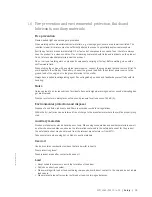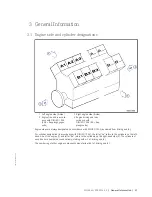
Compressed air
Observe special safety precautions when working with compressed air:
• Unauthorized use of compressed air, e.g. forcing flammable liquids (hazard class AI, AII and B) out of con-
tainers, risks causing an explosion.
• Wear goggles when blowing dirt off workpieces or blowing away swarf.
• Blowing compressed air into thin-walled containers (e.g. containers made of sheet metal, plastic or glass)
for drying purposes or to check for leaks risks bursting them.
• Pay special attention to the pressure in the compressed air system or pressure vessel.
• Assemblies or products which are to be connected must be designed to withstand this pressure. Install
pressure-reducing or safety valves set to the admissible pressure if this is not the case.
• Hose couplings and connections must be securely attached.
• Provide the snout of the air nozzle with a protective disk (e.g. rubber disk).
• Release residual pressure before removing or replacing pneumatic equipment in the supply line. To de-
pressurize compressed-air lines, shut off the lines first, then release the residual pressure.
• Carry out leak test in accordance with the specifications.
Painting
• Observe the relevant safety data sheet for all materials.
• When carrying out painting work outside the spray stands provided with fume extraction systems, ensure
that the area is well ventilated. Make sure that neighboring work areas are not adversely affected.
• There must be no naked flames in the vicinity.
• No smoking.
• Observe fire-prevention regulations.
• Always wear a mask providing protection against paint and solvent vapors.
Liquid nitrogen
• Observe the relevant safety data sheet for all materials.
• Work with liquid nitrogen may be carried out only by qualified personnel.
• Store liquid nitrogen only in small quantities and always in specified containers without fixed covers.
• Avoid body contact (eyes, hands).
• Wear protective clothing, protective gloves, closed shoes and safety goggles.
• Make sure that working area is well ventilated.
• Avoid knocking or jolting the containers, valves and fittings or workpieces in any way.
Acids/alkaline solutions/urea (AdBlue
®
, DEF)
• Observe the relevant safety data sheet for all materials.
• When working with acids and alkaline solutions, wear goggles or face mask, gloves and protective cloth-
ing.
• Do not inhale vapors.
• If urea solution is swallowed, rinse out mouth and drink plenty of water.
• Remove any wet clothing immediately.
• After contact skin, wash body areas with plenty of water.
• Rinse eyes immediately with eyedrops or clean tap water. Seek medical attention as soon as possible.
14 | Safety | M015565/03E 2016-02
TIM-ID: 0000040536 - 010















































